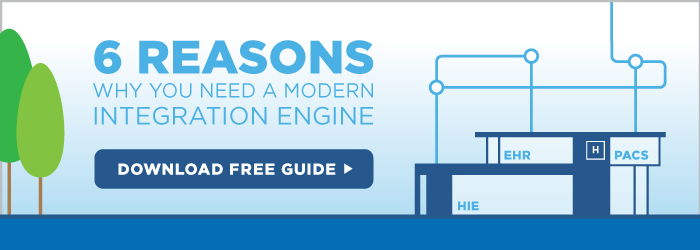
Welcome to the first part in iNTERFACEWARE’s series of blog posts on MACRA (Medicare Access and CHIP Reauthorization Act of 2015). Over the course of the next few weeks, we will take a look at the implications that MACRA will have for clinicians and healthcare providers when it comes to reporting and collecting reimbursements. We will also look at the role a modern integration plays in all of this, and why using one can potentially lead to substantially higher reimbursements for clinicians and save hospitals valuable time and money when creating reports.
For part one in our series, we will focus on the the impact that MACRA will have on clinicians and how an integration engine can lead to higher reimbursements for their services. First however, we’ll give a brief overview of MACRA: what it is, what the CMS hopes to accomplish with the act, and how clinicians will be scored under the new Merit-based Incentive Payment System (MIPS).
If you are looking for the second part in our series on MACRA, “Three Reasons Why MACRA Will Have a Big Impact on Hospitals”, click here.
MACRA also referred to as the “Permanent Doc Fix”, is the largest healthcare reform in the United States since the Affordable Care Act. MACRA, signed into law on April 16th, 2015, makes significant changes to the way Medicare doctors are reimbursed by rewarding quality care over volume and by repealing the Sustainable Growth Rate (SGR) formula.
The new reimbursement system is called the Quality Payment Program (QPP) and it consists of two tracks: the Merit-based Incentive Payment System (MIPS) and Advanced Alternative Payment Models. This article will focus on MIPS and how an integration engine can help eligible clinicians receive more money in reimbursements.
To encourage this transition to quality-based reimbursements, the program includes financial incentives. The amount of money that eligible clinicians receive in reimbursements each year is directly tied to its MIPS composite performance score. The composite performance score (CPS) is broken down into the following weighted categories:
- Quality – 60%
- Advancing Care Information (ACI, formerly Meaningful Use) – 25%
- Clinical Practice Improvement Activities – 15%
- Cost – 0% (for 2017 only)
The weight associated with each of these four categories will shift throughout the duration of the program. For more information on the MIPS performance score, click here.
Evidently, MIPS represents a major shift in the way that medicare clinicians are paid and it is critical that clinicians achieve a high composite performance score in order to receive reimbursements for their services.
An integration engine can help clinicians score, track and report better in all four categories, potentially resulting in a significant increase in reimbursements. Below, we’ll examine each of the four categories and give an example of how the use of an integration engine can lead to a higher score for each.
Quality
The quality portion of the composite performance score adopts many of the measures and reporting methods from the previous VBM and PQRS programs. In this category clinicians will report up to six measures (down from the previous nine that were required with PQRS), one of which must be an outcome measure. The final MACRA rule intends to move clinicians towards using a single data submission method for multiple performance categories of MIPS.
Integration is no longer an option with the new reporting requirements. Clinicians and providers need to integrate and streamline the data – ensuring it is easy to receive from various data points, and share with outsiders. This process can be made a lot easier with the use of a robust integration engine that is capable of connecting to any system and process any data type using any protocol.
Using an integration engine as a data warehouse point can also save clinicians and providers thousands of dollars. Reporting through an EHR is rarely free. Providers will need to pay either per report type or be forced to manually combine data from canned reports. The Iguana Integration Engine can be used to create dashboards and reports for any and all required information – that can be accessed in real time with no additional costs.
Clinicians can no longer live in silos; patient data needs to be easily accessible and transferable across healthcare systems.
Advancing Care Information
The Advancing Care Information (formerly Meaningful Use) portion of the composite performance score emphasizes clinicians’ usage of health IT and information exchange. ACI uses a benchmark scoring system whereby clinicians will earn performance points based on how they compare to other clinicians. This represents a change from Meaningful Use where clinicians just had to meet the compliance threshold on any given MU measure.
How can an integration engine help clinicians score better in the ACI component of the MIPS composite performance score? One of of the objectives that clinicians can report on (which in turn helps determine their base score) is Health Information Exchange (HIE). An integration engine that is flexible enough to connect to any HIE will greatly assist clinicians in scoring better in the HIE objective.
Another objective that clinicians can report on is coordination of care through patient engagement and one of the three measures for this objective is patient-generated health data. Patients are collecting more data than ever before through the use of mobile apps and wearables. To allow patients to upload this health data to a patient portal, the portal will need to be able to connect to these apps and wearables (from various departments) which can be made possible by an integration engine.
Clinical Practice Improvement Activities
The goal of clinical practice improvement activities is to recognize clinicians who are actively participating in care coordination, patient safety, and patient engagement activities such as patient portals.
The use of a robust and modern integration engine can go a long way in helping clinicians score better in activities related to patient engagement. For example, clinicians who choose the “provide enhanced patient portals” activity will significantly benefit from an integration engine that will connect with all of their hospitals systems, providing a more fully featured portal for patients. The end result is more participation in the portal by patients which leads to a higher score in the activity, and thus a better overall CPIA score.
A modern integration engine can also help healthcare providers improve their continuation of care scores by easily connecting to transitional care facilities regardless of the systems they use and by improving their referral management systems through automation.
Cost
The cost section will not be factored into the MIPS composite performance score for the first year, but will be used starting in 2018. Due to the fact that the measures for cost are calculated based on claims collected by CMS, clinicians will not have to do any additional reporting. The goal of the cost portion of MIPS is pretty straightforward – reduce the amount of resources required to deliver quality care to patients.
Implementing an integration engine can do wonders for improving operational efficiencies in hospitals, thus reducing the amount of resources required to deliver care. Administrative tasks such as processing billing requests and manually filling out paperwork represent a substantial portion of health care costs for hospitals. Streamlining these tasks with with an integration engine that integrates with your EHR and all of your hospital’s systems should be a priority for every hospital. The Iguana Integration Engine can integrate with any EHR, billing system, LIS, RIS, and any other hospital system you use; the end result? Countless hours saved and significant cost saving, thereby allowing clinicians to deliver patient care at a much lower cost.

